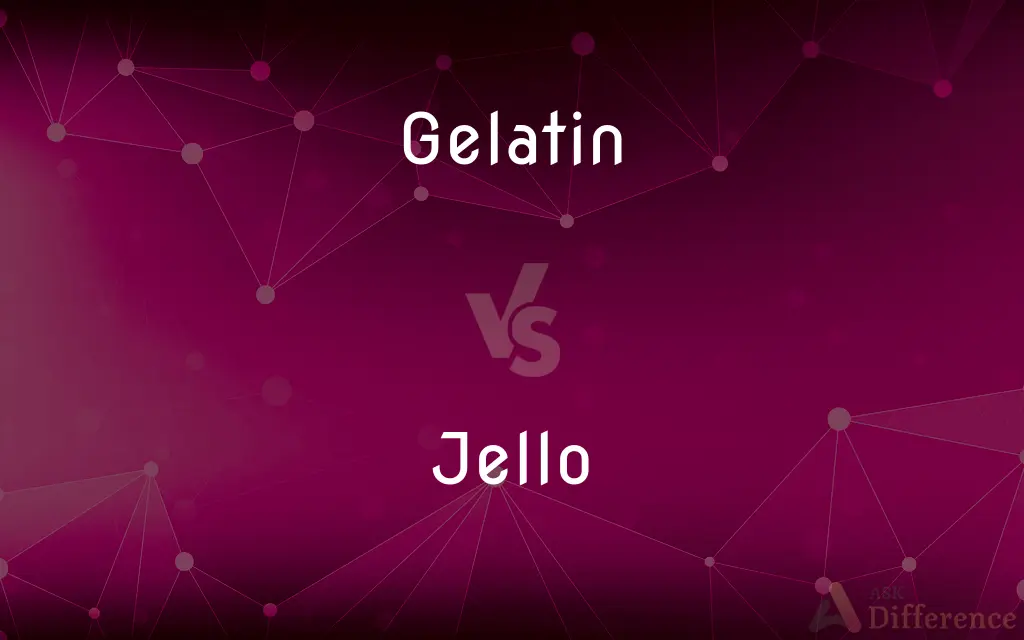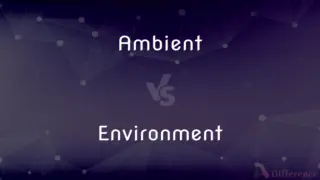Gelatin vs. Jello — What's the Difference?
By Tayyaba Rehman — Updated on October 11, 2023
Gelatin is a protein derived from animal collagen used as a gelling agent. Jello is a brand of gelatin-based dessert. They differ in function and context, with the former being a generic substance and the latter a branded product.

Difference Between Gelatin and Jello
Table of Contents
ADVERTISEMENT
Key Differences
Gelatin is a translucent, colorless, and flavorless substance that is derived from animal collagen. It is a protein produced by partial hydrolysis of collagen extracted from animal bones, skin, and tissues. Used widely in the food industry, gelatin acts as a gelling agent, thickener, and stabilizer. On the other hand, Jello refers to a specific brand of gelatin desserts, which come in various flavors and colors. It's a product that utilizes gelatin as one of its main ingredients to achieve its wobbly and jiggly consistency.
While gelatin itself is neutral in taste and aroma, Jello is flavored and sweetened. You can buy plain gelatin in powder or sheet form, and it can be used in a myriad of recipes, from savory aspics to marshmallows. Jello, however, is often sold in pre-flavored packets, ready to be mixed with water and set in molds or dishes. It's a dessert that's recognized by its vibrant colors and fruity flavors, appealing to both children and adults.
The applications of gelatin extend beyond the culinary world. Gelatin is utilized in pharmaceuticals, cosmetics, and photography due to its binding and gelling properties. Jello, as a branded dessert, is primarily a food product. Its cultural significance, especially in American households, is notable, with the brand often being used generically to refer to any gelatin dessert.
To reiterate, while gelatin is a versatile substance with multiple applications, Jello is a product with a specific use – to be enjoyed as a dessert. It's essential to understand the distinction, especially in cooking, as using one in place of the other based on brand versus ingredient can yield different results.
Comparison Chart
Definition
A protein derived from animal collagen.
A brand of gelatin-based dessert.
ADVERTISEMENT
Taste & Aroma
Neutral and unflavored.
Flavored and sweetened.
Form
Available in powder or sheets.
Usually in pre-flavored packets.
Applications
Food, pharmaceuticals, cosmetics, photography.
Primarily consumed as a dessert.
Branding
Generic term, not tied to a brand.
Specific brand of gelatin desserts.
Compare with Definitions
Gelatin
A protein resulting from partial collagen hydrolysis.
The jelly's texture is due to the gelatin it contains.
Jello
An iconic American dessert coming in various flavors.
Lime Jello is her favorite because of its tangy taste.
Gelatin
A substance used in food, pharmaceuticals, and cosmetics.
The pill's outer shell contains gelatin to ensure smooth swallowing.
Jello
A brand of gelatin-based flavored desserts.
Kids love making and eating Jello for its wobbly fun.
Gelatin
A gelling agent derived from animal collagen.
She used gelatin to set her homemade panna cotta.
Jello
A product known for its jiggly consistency.
After setting overnight, the Jello was ready to be served.
Gelatin
A clear and flavorless compound used in cooking and baking.
Gelatin sheets are preferred by many chefs for their precision.
Jello
Often a go-to dessert due to its easy preparation.
When short on time, she opts for Jello as a quick dessert solution.
Gelatin
An ingredient that provides elasticity, consistency, and stability.
The mousse owes its light, airy texture to gelatin.
Jello
A colorful and sweet gelatinous treat.
She prepared strawberry Jello for the party.
Gelatin
Gelatin or gelatine (from Latin: gelatus meaning "stiff" or "frozen") is a translucent, colorless, flavorless food ingredient, commonly derived from collagen taken from animal body parts. It is brittle when dry and gummy when moist.
Jello
A fruit-flavoured gelatin dessert made up from a commercially prepared powder.
Gelatin
A colorless or slightly yellow, transparent, brittle protein formed by boiling the specially prepared skin, bones, and connective tissue of animals and used in foods, drugs, and photographic film.
Jello
(North America) A dessert made by boiling flavoured gelatin in water
Gelatin
Any of various similar substances.
Jello
Fruit-flavored dessert (trade mark Jell-O) made from a commercially prepared gelatin powder
Gelatin
A jelly made with gelatin, used as a dessert or salad base.
Gelatin
A thin sheet made of colored gelatin used in theatrical lighting. Also called gel.
Gelatin
A protein derived through partial hydrolysis of the collagen extracted from animal skin, bones, cartilage, ligaments, etc.
Gelatin
An edible jelly made from this material.
Gelatin
A thin, translucent membrane used as a filter for photography or for theatrical lighting effects.
Gelatin
Animal jelly; glutinous material obtained from animal tissues by prolonged boiling. Specifically (Physiol. Chem.), a nitrogeneous colloid, not existing as such in the animal body, but formed by the hydrating action of boiling water on the collagen of various kinds of connective tissue (as tendons, bones, ligaments, etc.). Its distinguishing character is that of dissolving in hot water, and forming a jelly on cooling. It is an important ingredient of calf's-foot jelly, isinglass, glue, etc. It is used as food, but its nutritious qualities are of a low order.
Gelatin
A colorless water-soluble glutinous protein obtained from animal tissues such as bone and skin
Gelatin
An edible jelly (sweet or pungent) made with gelatin and used as a dessert or salad base or a coating for foods
Gelatin
A thin translucent membrane used over stage lights for color effects
Common Curiosities
What is Gelatin made from?
Gelatin is derived from animal collagen, typically from bones and skin.
Can I make my own flavored gelatin dessert without using Jello?
Absolutely! You can use plain gelatin and add your choice of flavors, sweeteners, and colors.
Why do some desserts ask for gelatin sheets while others specify powder?
Gelatin sheets and powder have different gelling strengths and properties. Recipes may specify one over the other for consistency and desired texture.
Is Jello the same as all gelatin desserts?
No, Jello is a specific brand of gelatin desserts, but many people use the term generically.
Is the gelatin in Jello different from store-bought plain gelatin?
The basic ingredient, gelatin, is similar, but Jello includes flavors, colors, and sweeteners.
How is gelatin used in the pharmaceutical industry?
Gelatin is often used in making capsules due to its smooth texture and dissolvable nature.
Can vegans eat Jello?
Traditional Jello contains animal-derived gelatin, so it's not vegan. However, vegan alternatives exist using plant-based gelling agents.
How long does it typically take for Jello to set?
Jello usually sets in 3-4 hours when refrigerated, but it's best to follow the packet instructions.
Can vegetarians consume gelatin?
Traditional gelatin is animal-based, so it's not vegetarian-friendly. However, there are vegetarian gelatin alternatives.
Why does Jello have a wobbly and jiggly texture?
The jiggly consistency of Jello is due to the gelatin it contains, which gels the liquid as it cools.
Are there any health benefits associated with consuming gelatin?
Yes, gelatin is a source of protein and amino acids and may support joint and skin health.
Why is gelatin sometimes used in cosmetics?
Gelatin can act as a binder, thickener, or texture enhancer in cosmetics, making products smoother and more spreadable.
Is there a difference in the setting strength between different Jello flavors?
Generally, the setting strength across Jello flavors is consistent, but the texture might vary slightly due to flavor additives.
What happens if I heat a set gelatin dessert or Jello too much?
Excessive heat can cause the gelatin to melt and lose its set consistency, returning it to a liquid state.
Share Your Discovery

Previous Comparison
Stream vs. Creek
Next Comparison
Ambient vs. EnvironmentAuthor Spotlight
Written by
Tayyaba RehmanTayyaba Rehman is a distinguished writer, currently serving as a primary contributor to askdifference.com. As a researcher in semantics and etymology, Tayyaba's passion for the complexity of languages and their distinctions has found a perfect home on the platform. Tayyaba delves into the intricacies of language, distinguishing between commonly confused words and phrases, thereby providing clarity for readers worldwide.














































